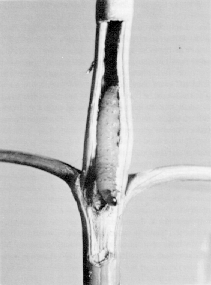Boxelder Twig Borer
ENTFACT-415: Boxelder Twig Borer | Download PDF
by Lee Townsend, Extension Entomologist
University of Kentucky College of Agriculture

The boxelder twig borer, a small whitish yellow caterpillar with a dark head, destroys the buds and tender shoots of boxelder and red maple. Feeding by this insect can cause trees to become bushy and to lose their natural shape. By the time symptoms appear, the caterpillars have bored into the twig and are safe from any type of control measure. Any attempt to reduce damage to infested plants must be done before the small caterpillars have tunneled into the plant.
Life Cycle
Eggs hatch in mid-July and the small larvae feed for a short time on leaves. While feeding, they cover the area with silk which contains small waste pellets. In autumn the larva bores into leaf petioles or dormant buds and spends the winter there. In the spring, the caterpillar becomes active again and bores into a new shoot to complete its development. The damaged shoot becomes swollen and waste pellets can be seen around the small entry hole. Again, the larval stage is inside the plant and not vulnerable to control.
Once an infestation has been detected, control measures must be directed toward the leaf feeding stage which is active in mid-July. Carbaryl (Sevin) should have a long enough residual to give satisfactory reduction of an infestation. Treat in late July and again in early August. Use sufficient water to get good coverage of the leaves.
Revised: 7/19
CAUTION! Pesticide recommendations in this publication are registered for use in Kentucky, USA ONLY! The use of some products may not be legal in your state or country. Please check with your local county agent or regulatory official before using any pesticide mentioned in this publication.
Of course, ALWAYS READ AND FOLLOW LABEL DIRECTIONS FOR SAFE USE OF ANY PESTICIDE!
Images: University of Kentucky Entomology.
